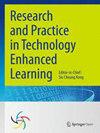The influence of gender on STEM career choice: A partial least squares analysis
IF 3
Q1 EDUCATION & EDUCATIONAL RESEARCH
Research and Practice in Technology Enhanced Learning
Pub Date : 2023-11-08
DOI:10.58459/rptel.2024.19025
引用次数: 0
Abstract
Students’ participation in science, technology, engineering, and mathematics (STEM) is still one of the most critical worldwide educational challenges despite efforts to promote STEM. Debates about gender disparities in STEM careers also remain perpetual. Early documented literature suggested shifts in students’ STEM choices were due to students’ significant others, media exposure and attitude. Therefore, the first aim of this paper was to examine the direct and indirect relationships in a proposed model, and analyze the mediating roles of media exposure and students’ attitude in the relationship between subjective norms and STEM career choice intention. The second aim was to analyze the moderating role of students’ gender. Respondents of this study were 806 secondary school students in Malaysia. Based on the results from partial least squares structural equation modeling, (i) subjective norms had both direct and indirect influence on students’ career choice intention in STEM, (ii) media exposure and students’ attitude were significant mediators between subjective norms and career choice intention in STEM, and (iii) gender moderated the influence of subjective norms on media exposure. The findings drawn from this study provide insights into the design and development of STEM initiatives for parents, teachers, and peers by considering the importance of the media, students’ attitude, and gender. Recommendations for policy and practice enhancements were suggested for future research directions to support STEM interventions in Malaysia.性别对STEM职业选择的影响:偏最小二乘分析
尽管努力促进STEM,但学生参与科学、技术、工程和数学(STEM)仍然是世界范围内最关键的教育挑战之一。关于STEM职业中性别差异的争论也一直存在。早期文献表明,学生STEM选择的转变是由于学生的重要他人、媒体曝光和态度。因此,本文的第一个目的是检验所提出的模型中的直接和间接关系,并分析媒体暴露和学生态度在主观规范与STEM职业选择意愿关系中的中介作用。第二个目的是分析学生性别的调节作用。本研究的调查对象为马来西亚的806名中学生。基于偏最小二乘结构方程模型的结果表明:(1)主观规范对STEM专业学生职业选择意愿有直接和间接的影响,(2)媒体暴露和学生态度是主观规范与STEM专业学生职业选择意愿之间的显著中介,(3)性别调节了主观规范对媒体暴露的影响。通过考虑媒体、学生态度和性别的重要性,本研究得出的结果为家长、教师和同龄人设计和开发STEM计划提供了见解。为未来的研究方向提出了政策和实践改进建议,以支持马来西亚的STEM干预。
本文章由计算机程序翻译,如有差异,请以英文原文为准。
求助全文
约1分钟内获得全文
求助全文
来源期刊

Research and Practice in Technology Enhanced Learning
Social Sciences-Education
CiteScore
7.10
自引率
3.10%
发文量
28
审稿时长
13 weeks
 求助内容:
求助内容: 应助结果提醒方式:
应助结果提醒方式:


